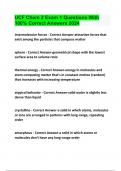London dispersion - Study guides, Class notes & Summaries
Looking for the best study guides, study notes and summaries about London dispersion? On this page you'll find 316 study documents about London dispersion.
Page 4 out of 316 results
Sort by
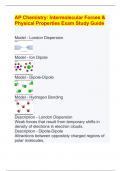
-
AP Chemistry: Intermolecular Forces & Physical Properties Exam Study Guide
- Exam (elaborations) • 5 pages • 2024
- Available in package deal
-
- $12.99
- + learn more
AP Chemistry: Intermolecular Forces & Physical Properties Exam Study Guide Model - London Dispersion Model - Ion Dipole Model - Dipole-Dipole Model - Hydrogen Bonding Description - London Dispersion Weak forces that result from temporary shifts in density of electrons in electron clouds. Description - Dipole-Dipole Attractions between oppositely charged regions of polar molecules.
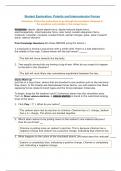
-
Student Exploration: Polarity and Intermolecular Forces Questions with Correct Answers
- Exam (elaborations) • 12 pages • 2023
- Available in package deal
-
- $10.49
- + learn more
Vocabulary: dipole, dipole-dipole force, dipole-induced dipole force, electronegativity, intermolecular force, ionic bond, London dispersion force, molecule, nonpolar, nonpolar covalent bond, partial charges, polar, polar covalent bond, valence electron Prior Knowledge Questions (Do these BEFORE using the Gizmo.) 1. A big bully is having a tug-of-war with a small child. There is a ball attached to the middle of the rope. Toward whom will the ball move?
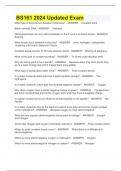
-
BS161 2024 Updated Exam
- Exam (elaborations) • 31 pages • 2024
-
- $9.99
- + learn more
BS161 2024 Updated Exam What type of bond occurs between molecules? - ANSWER Covalent bond Blank unwinds DNA - ANSWER Helicase DNA polymerase can only add nucleotides to the 3' end of an blank strand - ANSWER Existing What forces occur between molecules? - ANSWER Ionic, hydrogen, hydrophobic clustering and london dispersion forces Covalent bonds involve To fill outer electron shells - ANSWER Sharing of electrons. What is the goal of covalent bonding? - ANSW...
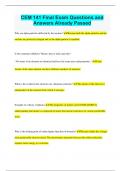
-
CEM 141 Final Exam Questions and Answers Already Passed
- Exam (elaborations) • 9 pages • 2024
- Available in package deal
-
- $9.99
- + learn more
CEM 141 Final Exam Questions and Answers Already Passed Why are alpha particles deflected by the nucleus? Because both the alpha particles and the nucleus are positively charged and so the alpha particle is repelled. Is this statement (Dalton's Theory) true or false and why? "All atoms of an element are identical and have the same mass and properties." False. Atoms of the same element can have different numbers of neutrons. What is the evidence that electrons are subatomic pa...
UCF Chem 2 Exam 1 Questions With 100% Correct Answers 2024

-
Inorganic Chemistry 2 Exam Review With 100% Correct Answers 2024
- Exam (elaborations) • 10 pages • 2024
- Available in package deal
-
- $11.49
- + learn more
Inorganic Chemistry 2 Exam Review With 100% Correct Answers 2024 1) Which of the following statements about gases is false? A) All gases are colorless and odorless at room temperature. B) Distances between molecules of gas are very large compared to bond distances within molecules. C) Gases expand spontaneously to fill the container they are placed in. D) Gases are highly compressible. E) Non-reacting gas mixtures are homogeneous. - answerA) All gases are colorless and odorless at room ...
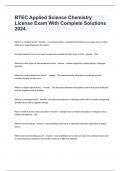
-
BTEC Applied Science Chemistry License Exam With Complete Solutions 2024.
- Exam (elaborations) • 4 pages • 2024
-
Available in package deal
-
- $9.99
- + learn more
What is a covalent bond? - Answer A covalent bond is a chemical bond that occurs when one or more electron is shared between the atoms. all intermolecular forces are much weaker than covalent bonds. True or False - Answer True. What are three types of intermolecular forces - Answer London dispersion, dipole-dipole, hydrogen bonding What are London dispersion forces? - Answer The intermolecular attractions resulting from the constant motion of electrons. What is a dipole-dipol...
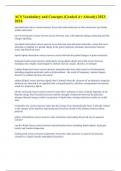
-
ACS Vocabulary and Concepts (Graded A+ Already) 2023-2024.
- Exam (elaborations) • 11 pages • 2024
-
Available in package deal
-
- $10.29
- + learn more
intermolecular forces correct answers forces that hold molecules to other molecules (not bonds within molecules) ion-ion interaction correct answers occurs between ions, with opposite charges attracting and like charges repelling ion-dipole interaction correct answers occur between ions and polar molecules, where the ion is attracted or repelled to a partial charge in the polar molecules (includes interactions between water and dissolved ions) dipole-dipole interaction correct answers o...

-
PORTAGE LEARNING M2: PROBLEM SET BIOCHEMISTRY
- Exam (elaborations) • 12 pages • 2023
-
Available in package deal
-
- $10.99
- + learn more
M2: Problem Set Due No due date Points 5 Questions 20 Time Limit None Attempt History Attempt Time Score LATEST Attempt 1 1,309 minutes 5 out of 5 Score for this quiz: 5 out of 5 Submitted Feb 24 at 4:02pm This attempt took 1,309 minutes. Question 1 0 / 0 pts Your Answer: What is the shape of water? Bent Bent. The bond angle is 104.5 degrees. Question 2 0 / 0 pts What is autoionization, and how is it important for water? PORTAGE LEARNING M2: PROBLEM SET BIOCHEMISTRY Your Answer: ...
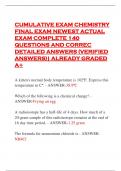
-
CUMULATIVE EXAM CHEMISTRY FINAL EXAM NEWEST ACTUAL EXAM COMPLETE 140 QUESTIONS AND CORREC DETAILED ANSWERS (VERIFIED ANSWERS)| ALREADY GRADED A+ A kitten's normal body temperature is 102ºF. Express this temperature in Cº. - ANSWER-38.9ºC Which of the f
- Exam (elaborations) • 25 pages • 2024
-
- $13.99
- + learn more
CUMULATIVE EXAM CHEMISTRY FINAL EXAM NEWEST ACTUAL EXAM COMPLETE 140 QUESTIONS AND CORREC DETAILED ANSWERS (VERIFIED ANSWERS)| ALREADY GRADED A+ A kitten's normal body temperature is 102ºF. Express this temperature in Cº. - ANSWER-38.9ºC Which of the following is a chemical change? - ANSWER-Frying an egg A radioisotope has a half-life of 4 days. How much of a 20-gram sample of this radioisotope remains at the end of 16 day time period. - ANSWER-1.25 gram The formula for ammoniu...

Did you know that on average a seller on Stuvia earns $82 per month selling study resources? Hmm, hint, hint. Discover all about earning on Stuvia

